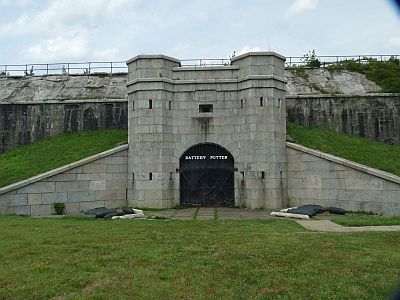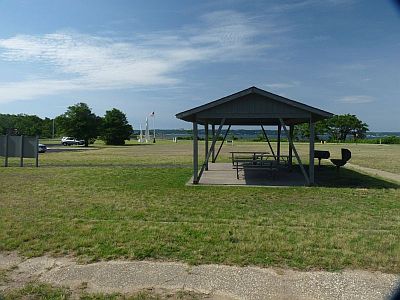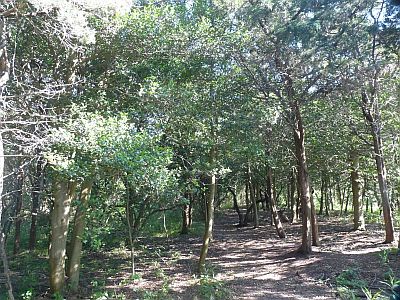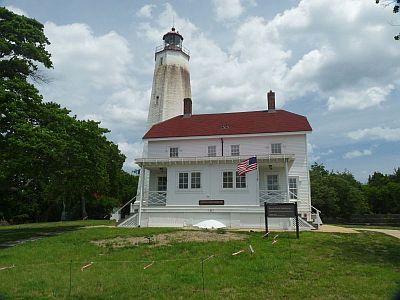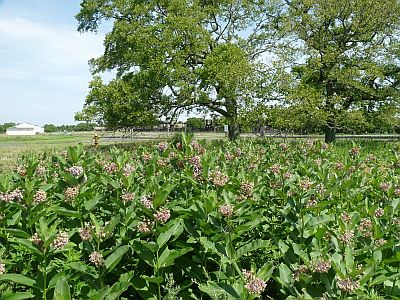New Jersey Butterfly Club
A chapter of the North American Butterfly Association (NABA)
Sandy Hook (Gateway National Recreation Area)
by Keith Richmond
County: Monmouth.
Municipality: A unit of Gateway National Recreation Area.
Directions: From North Jersey and New York: Head south on the Garden State Parkway to Exit 117 (Keyport/Hazlet) - After toll, bear left and follow Route 36 East - 13 miles to park entrance (when crossing the Highlands Bridge stay right and take the jug-handle to enter the park).
From South Jersey: Head north on Garden State Parkway to Exit 105 (Eatontown), bear left for Route 36 East. Continue on Route 36 East, pass Monmouth Mall and across Route 35 through Eatontown and Long Branch (Route 36 is called Joline Avenue here). Continue on Route 36, which turns left and follows north along ocean (Route 36 is called Ocean Blvd. here). North for six miles through the towns of Long Branch, Monmouth Beach and Sea Bright to park.
From Philadelphia & Camden, New Jersey: Take New Jersey Turnpike north to Exit 7A (Shore Points) onto I-195. East on I-195, to Garden State Parkway north. GSP north to Exit 105 (Eatontown). Then follow "From South Jersey" directions above.
Parking and Restrooms: Restrooms and parking areas are scattered throughout the park. This map shows you where to find them. Here is a more detailed map of the Fort Hancock Historic Area. Note that if you visit during the summer months, a $20/day parking fee (as of 2023) applies if you plan to park in any of the lots which give access to the beach. These are marked with “US Fee Area” signs (Lots B, C, D, E, G, I, J, and K). You must let the toll booth attendant at the entrance know that you are there to observe nature and will not be using any of the beach lots if you wish to avoid the fee. In addition during summer, when parking areas are filled, the park closes to new traffic until spaces become available. You can avoid traffic and delays by arriving before 10am or after 2pm.
Nearest sizable town: Return to NJ Route 36 north to find Highlands (4 miles) and Atlantic Highlands (6 miles) where gas and restaurants can be found. Note that the business districts of both these towns are found to the east of NJ 36. Sea Bright can be reached 5.5 miles south on NJ 36.
Habitats: Sandy Hook is a 2,044 acre barrier beach peninsula at the northern tip of the New Jersey shore. The park has a variety of habitats including seven miles of ocean beaches, extensive vegetated dune habitat, tidal salt marshes and mudflats, and two tracts of maritime forest, one of which is the largest remaining tract in NJ. Sandy Hook is an oasis for many varieties of flora and fauna that thrive on the site's unique ecology.
Maintained/Marked trails: Yes. A paved “Multi-use” path runs the entire length of the park which receives heavy use from the many bicyclists who visit here. There is also an informal set of sandy trails which traverse the center of the Hook.
Picnic tables: Tables under covered pavilions may be found in Guardian Park Picnic Area at the southern end of the Fort Hancock Historic District.
Notable species: Checkered White, Cloudless Sulphur, American Copper, Coral Hairstreak, Henry's Elfin, Juniper Hairstreak, Gray Hairstreak, Red-banded Hairstreak, American Snout, Common Buckeye, Hackberry Emperor, Tawny Emperor, Fiery Skipper, and Sachem.
Best time to visit: In order to avoid both the huge beach crowds as well as the parking fee (see Parking section above) that occur from Memorial Day to Labor Day, spring and fall are the best times to go. If you do visit during the summer, visiting during the week will of course avoid the heaviest crowds.
Exploring Sandy Hook: Perhaps the best approach to butterflying at the Hook is to move between each of several parking lots using them as a base of operations to explore the surrounding territory. Walk the road edges and various trails as well as the many forest openings you will find along the way looking for promising nectar sources. Among the many such possibilities, in spring you can find flowering beach plum, summer brings out milkweed and privet, while seaside goldenrod is common in fall.
On the east side of Hartshorne Drive (the main north/south road through the park) between Lots D and E (across from Spermaceti Cove) is a small lot for the historic life saving station. This building was formerly park Visitor Center but is now closed due to Hurricane Sandy storm damage. However, you can still explore along the multi-use pathway. The southern terminus of the Old Dune Trail is found here which leads through a section of the holly forest.
Driving further north you will reach 2 lots across from Horseshoe Cove - Lot L on your right just past where Atlantic Avenue branches off to the right and Lot H a bit further on, also on your right. These lots allow you to access the Campground, the former Nike Missile Radar Site, and the northern terminus of the South Beach Dune Trail.
The Fort Hancock area has several parking areas providing opportunities for exploration. Parking at or near the Lighthouse (and current Visitor Center) is a good spot from which to check out the southern areas of Fort Hancock. There is a small lot at Battery Potter on Hudson Road. Walk this road south past Battery Granger to Mortar Battery and back. Finally, park in Lot M (the most northerly lot in the park) near Nine Gun Battery. From here you can explore the surrounding fields, dunes, and the grassy area in front of Nine Gun Battery. There is also a trail that starts here that leads toward the northern tip of Sandy Hook.
Special precautions: In addition to the chance of bothersome mosquitoes and ticks in the wooded areas, you should be prepared for encounters with poison ivy. Sandy Hook may be the state's capital for this dreaded plant.
Another hazard to guard against is a speeding ticket from the National Park rangers. The 35 mph speed limit is rigorously enforced with radar units. Also pay attention to the posted parking regulations; the park rangers will notice cars along the sides of roads and ticket them. What's worse, you may get stuck in loose sand that could cost you valuable time in getting free.
Sandy Hook is a carry in/carry out park (glass containers are prohibited) so please remove all your trash.
The many crumbling concrete batteries and sea walls are extremely dangerous and should be avoided.
You might also want to visit: Big Brook Park, Thompson Park, Tatum Park, Deep Cut Gardens.
